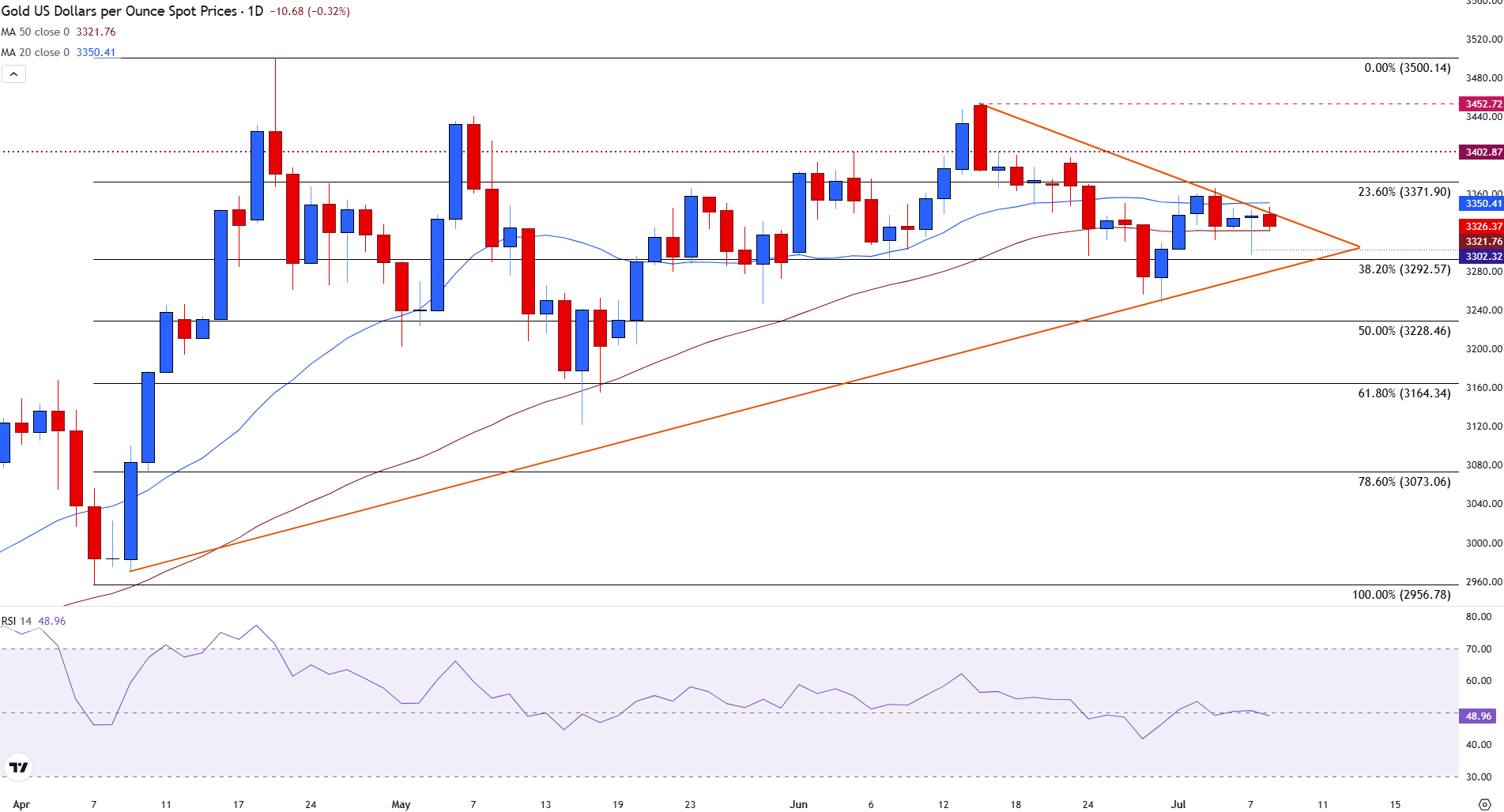Gold struggles for direction amid new tariff headlines
- Gold price struggles for direction as Trump delays higher tariffs and announces new ones for some countries.
- FOMC Meeting Minutes on Wednesday and expectations of delayed Fed interest rate cuts weigh on bullion.
- XAU/USD remains within the confines of a symmetrical triangle, with resistance firming at $3,350.
Gold (XAU/USD) remains in a well-defined range between $3,320 and $3,350 at the time of writing on Tuesday, amid a looming tariff deadline and potential trade deals.
US President Donald Trump’s consistent tariff threats have temporarily muted demand for the yellow metal while supporting the demand for the Greenback. The president has announced new tariffs on countries, with Japan at 25% and South Korea at 30% standing out. He has also given a new deadline, August 1, instead of July 9.
The yellow metal is down 0.43% intraday, and the lack of conviction reflects ongoing indecision amid conflicting macro forces and stable US Treasury yields.
The recent price action has been defined by a series of lower highs and higher lows, compressing into a classic triangle structure on the daily chart. This pattern typically precedes a sharp directional move, but the breakout trigger remains elusive.
While safe-haven demand offers some underlying support, stronger-than-expected US labor market data and hawkish Federal Reserve (Fed) expectations have capped any upside extension for Gold.
Gold daily digest market movers: XAU/USD remains alert ahead of FOMC Minutes
- The Federal Open Market Committee will release the Minutes from its last meeting on Wednesday. This report outlines the reasons for maintaining interest rates at the current range of 4.25% to 4.50% in June.
- German Industrial Production data, released on Monday, showed a 1.2% monthly increase in May. Upbeat economic data has helped drive recession fears lower, adding pressure on the yellow metal.
- The BRICS summit in Rio de Janeiro ended on Monday. The emerging market nations that established the bloc are beginning to reduce their reliance on the United States. This initiative includes moving away from using the US Dollar as a receiving currency, a concept known as de-dollarization.
- Trump wrote a post on Truth Social also on Monday stating that “Any country aligning themselves with the Anti‑American policies of BRICS, will be charged an ADDITIONAL 10 % tariff. There will be no exceptions to this policy.”
Gold trades sideways near $3,320 as triangle breakout looms
From a technical standpoint, Gold is holding above the 50-day Simple Moving Average (SMA) at $3,321, with the 20-day SMA acting as minor resistance at $3,350.
The current structure suggests a neutral bias. However, a sustained break below $3,292, the 38.2% Fibonacci retracement level of the April rally, would increase downside risk.
If Gold breaks below this level, it could trigger a downside move, signaling a bearish breakout from the symmetrical triangle.
Gold (XAU/USD) daily chart

On the upside, the precious metal could stage a strong upward move if it breaks above the upper boundary of the symmetrical triangle, particularly with a decisive close above the 20-day SMA at $3,350.
Additionally, any resurgence in geopolitical tensions or global trade disputes could trigger renewed safe-haven demand, further fueling a rally. If bullish momentum takes hold, XAU/USD may target the $3,375–$3,400 area, with the potential to retest all-time highs if broader risk sentiment deteriorates.
Gold FAQs
Gold has played a key role in human’s history as it has been widely used as a store of value and medium of exchange. Currently, apart from its shine and usage for jewelry, the precious metal is widely seen as a safe-haven asset, meaning that it is considered a good investment during turbulent times. Gold is also widely seen as a hedge against inflation and against depreciating currencies as it doesn’t rely on any specific issuer or government.
Central banks are the biggest Gold holders. In their aim to support their currencies in turbulent times, central banks tend to diversify their reserves and buy Gold to improve the perceived strength of the economy and the currency. High Gold reserves can be a source of trust for a country’s solvency. Central banks added 1,136 tonnes of Gold worth around $70 billion to their reserves in 2022, according to data from the World Gold Council. This is the highest yearly purchase since records began. Central banks from emerging economies such as China, India and Turkey are quickly increasing their Gold reserves.
Gold has an inverse correlation with the US Dollar and US Treasuries, which are both major reserve and safe-haven assets. When the Dollar depreciates, Gold tends to rise, enabling investors and central banks to diversify their assets in turbulent times. Gold is also inversely correlated with risk assets. A rally in the stock market tends to weaken Gold price, while sell-offs in riskier markets tend to favor the precious metal.
The price can move due to a wide range of factors. Geopolitical instability or fears of a deep recession can quickly make Gold price escalate due to its safe-haven status. As a yield-less asset, Gold tends to rise with lower interest rates, while higher cost of money usually weighs down on the yellow metal. Still, most moves depend on how the US Dollar (USD) behaves as the asset is priced in dollars (XAU/USD). A strong Dollar tends to keep the price of Gold controlled, whereas a weaker Dollar is likely to push Gold prices up.

